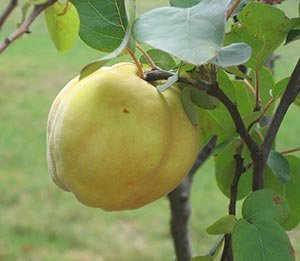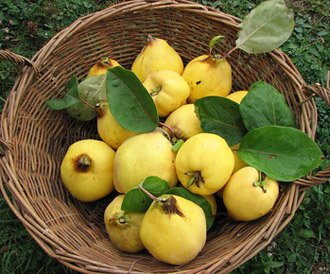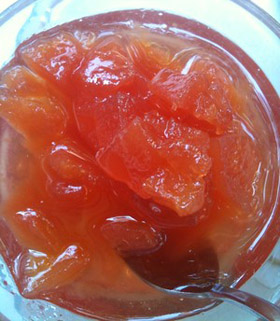Quince fruit Nutrition facts
Fragrant, delicious quince fruit is a member of the Rosaceae family of pome fruits. Native to Asia Minor, this once popular delicacy has taken the backseat in the modern times of the molecular biotechnology world. Quince is rarely eaten raw but employed in cooking where just a small section of it would impart the whole recipe with a pleasant fruity aroma.
Binomially, quince is the only fruiting tree in the Genus: Cydonia. Scientific name: Cydonia oblonga.
 |
| Quince fruit-Cydonia oblonga. |
Quinces are medium-sized semi-tropical deciduous trees, reaching about 10 to 15 feet in height. Pink-white flowers appear in the spring and early summer, which develop into pear-shaped, golden-colored fruits. The fruit is larger than medium apple and bumpy; look somewhat like giant guava, avocado, or as short-necked pear fruit. Its fuzzy surface is smooth as in peaches.
Quince fruit weighs about 250-750 g or more in some varieties. Inside, its flesh is light yellow, and gritty and has many seeds concentrated at its center as in apples. Raw quince has an intense fruity aroma and together with its bright yellow color instantly attracts the fruit lover’s attention. However, raw fruits, even after ripe, are generally astringent and tart.
Health benefits of Quince
Quince is low-calorie fruit. 100 g fresh raw fruit provides 57 calories. Besides, it composes several vital poly-phenolic antioxidants than apples and pears. The fruit is a storehouse of phytonutrients such as dietary fiber, minerals, and vitamins.
Quince flesh along with its peel contains good amounts of fiber. Further, its gritty granules in the pulp are composed of astringent compounds known as tannins namely, catechin and epicatechin. They bind to cancer-causing toxins and chemicals in the colon thereby protecting its mucosa from inflammatory bowel disease (IBD), cancers, and diverticulitis. Also, it helps reduce body weight and blood LDL cholesterol levels.
It has several phenolic compounds such as caffeoylquinic acid, procyanidin-B2, oligomeric procyanidin, polymeric procyanidin, etc., and essential oils like furfural, limonene, linalool, vomifoliol, toluene, ß-ionone, a-terpineol, etc. Together; these compounds give quince its unique fragrance.
Ripe quince fruit has a good concentration of vitamin-C. 100 g fruit provides 15 mg or 25% of RDA of vitamin-C. Fruits rich in this vitamin help remove harmful oxygen-free radicals from the body. Vitamin C helps boost immunity, reduce viral episodes and inflammatory conditions.
It is a good source of minerals such as copper (130 µg or 14% of RDA), iron, potassium, and magnesium as well as B-complex vitamins such as thiamin, riboflavin, and pyridoxine (vitamin B-6).
Although not well documented, quince fruit, like pears, has anti-allergenic and anti-inflammatory properties. The fruit as well as its seed extraction suggested in the treatment of cystitis, and atopic dermatitis, and recommended by health practitioners as a safe alternative in the preparation of food products for allergic people.
| Principle | Nutrient Value | Percent of RDA |
|---|---|---|
| Energy | 57 Kcal | 3% |
| Carbohydrates | 13.81 g | 11% |
| Protein | 0.40 g | <1% |
| Total Fat | 0.10 g | 0.5% |
| Cholesterol | 0 mg | 0% |
| Dietary Fiber | 1.9 g | 4% |
| Vitamins | ||
| Folates | 3 µg | 1% |
| Niacin | 0.200 mg | 1% |
| Pantothenic acid | 0.081 mg | 1.5% |
| Pyridoxine | 0.040 mg | 3% |
| Riboflavin | 0.030 mg | 2% |
| Thiamin | 0.020 mg | 2% |
| Vitamin A | 40 IU | 1% |
| Vitamin C | 15 mg | 25% |
| Vitamin E | 0.12 mg | 1% |
| Vitamin K | 4.5 µg | 4% |
| Electrolytes | ||
| Sodium | 1 mg | 0% |
| Potassium | 119 mg | 2.5% |
| Minerals | ||
| Calcium | 11 mg | 1% |
| Copper | 0.130 mg | 14% |
| Iron | 0.70 mg | 9% |
| Magnesium | 8 mg | 2% |
| Phosphorus | 11 mg | 2% |
| Selenium | 0.6 µg | 1% |
| Zinc | 0.04 mg | <1% |
Selection and Storage
Quince fruit season begins in September. Fresh fruits generally arrive in the US markets from the Middle East, Turkey, Armenia, and Georgia.
 |
| Quinces in a basket. Photo: jespahjoy |
In the markets, choose well-developed, firm, bright golden-yellow color fruits. Avoid green, immature, as they are bitter and inedible. Furthermore, avoid bruised, shriveled ones as they are out of flavor.
Once at home, they stay well for up to a week when kept open in a cool, dark place away from heat, and humidity. Quince fruit stores well for several weeks placed inside the refrigerator.
Preparation and Serving tips
Raw quince fruit is extremely sour and astringent as it is rarely eaten uncooked. Its bitter taste and raw sensation in the mouth area are due to certain chemicals in the fruit known as tannins. Cooking destroys these compounds while retaining aromatic, rich essential oils and aliphatic compounds. With the addition of sugar or honey, it makes an excellent ingredient in flavorful sweet, and savory recipes, jams, jellies, and preserves.
To prepare, just wash the fruit in cold water. Cut it in quarters, as you do in apples and pears. Remove the central core and seeds using a paring knife. Cut In small chunks or wedges and add in cooking.
Here are some serving tips:
 |
| Quince jam-membrillo. Photo courtesy: charkrem |
Quince fruit makes an excellent addition to the confectionery. Some of the traditional sweet delicacies like pies, tarts, cakes, jams (membrillo), marmalade, jellies, etc., employ this fruit to acquire a distinctive flavor.
The fruit pulp can also be employed in stews, as an addition to seafood, poultry, and lamb preparations as a flavoring base.
Safety profile
Quince fruit seeds are poisonous and should not be eaten. Raw fruit may cause irritation in the throat and may cause breathing difficulty. (Medical Disclaimer).
≺≺Back to Fruits from Quince fruit. Visit here for an impressive list of all varieties of fruits with complete illustrations of their nutrition facts and health benefits.
≺≺Back to Home page.
Further reading and Resources:
USDA National Nutrient Database.
Stanford School of Medicine Cancer information Page- Nutrition to Reduce Cancer Risk.